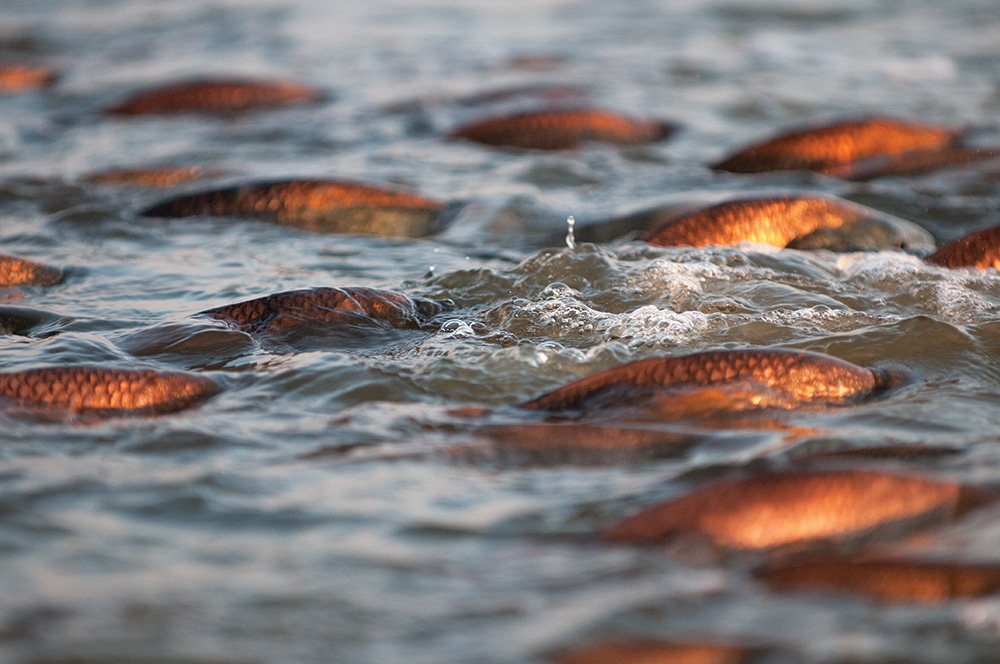
The sun began its slow creep up from the horizon, sending rays of orange bouncing off East Matagorda’s clear-green waters. Capt. Bink Grimes didn’t have to acknowledge the beautiful irony before us as we walked out onto the deck of his newly constructed Sunrise Lodge. Today would indeed be a special spring day — especially one for rod-bending redfish action.
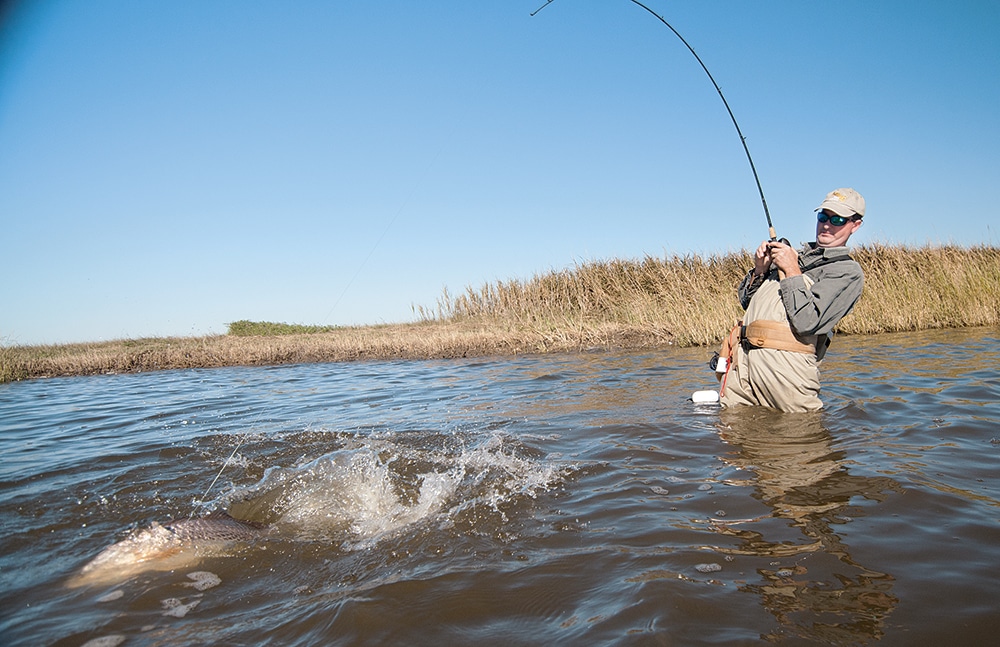
Walk This Way
Wade-fishing is as Texas as a good ol’ country song. From shallow, open-water sand flats to backcountry lagoons, anglers quietly depart from boats on a lure-chunking foot patrol, throwing everything from topwaters to plastics into schools of hungry fish. Grimes has honed both the technique and the timing; after all, he wrote the book on it: Wadefishing Texas, the source for fishermen up and down the Gulf Coast.
“We like to wade on the south shoreline of West Matagorda and work parallel guts that drop from knee-deep to waist-deep,” says Grimes. Matty — as the area is commonly called — is made up of two large bays, West and East Matagorda; in spring, both have strong neap tides that usher in clear, green seawater.
Riding those waves are bay anchovies. Commonly called glass minnows, anglers around here know they are really redfish and seatrout breakfast, lunch and dinner. Says Grimes, “We get that spring flood around spring break, and depending on how mild a winter we have, those glass minnows begin to show en masse.” The glass minnows pile into the shoreline grasses and guts for a game of hide-and-seek with predators. Redfish give themselves away with slicks and mud boils, but other species are in proximity, helping Grimes put his clients on forearm-burning action. “I get pretty excited when I see lots of pelicans divebombing because I know that the bait has arrived. Redfish will be close,” he says. “Real close.”
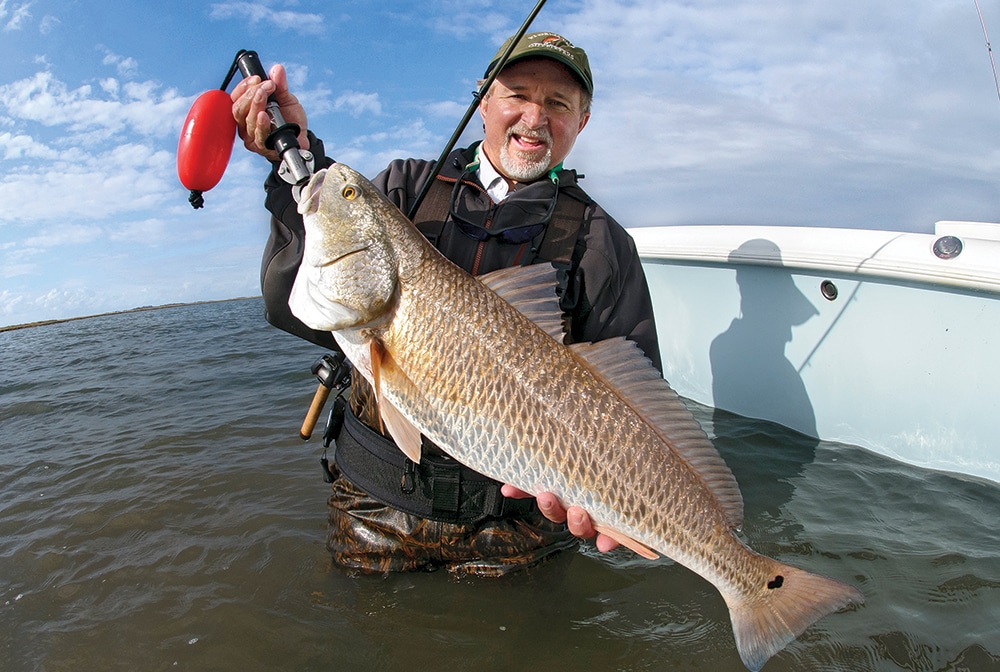
Weather or Not
Like Grimes, Capt. Ray Sexton has been guiding wade-fishermen for years. “Last season, I probably fished out of my boat twice. My clients prefer to wade because it is so much fun, and the success rate is high,” he says. Sexton looks forward to inclement weather. “I love it when we get those late-season fronts that drop air and water temperatures. Those events really get those redfish biting,” he says. He likes late-season fronts because the northeast wind pushes the bait and fish up along the long southern shorelines. “Glass minnows and mullet really get disoriented, and I like to be fishing in that.” As indication of his redfish prowess in inclement weather, Sexton released with his clients just the day before our arrival more than 100 fish in an afternoon. According to Grimes, both bays have been producing consistently good-size reds, and recently biologists have noted a real bloom. “The estuaries are holding healthy numbers of fish. Our numbers are strong and the fish are heavy, and we have seen a recent average of about 24 inches or six pounds on most trips,” says Grimes. He notes East Matty specifically. “We have seen big schools out in open water of East Bay. Typically we get more tidal flow because of the proximity of Mitchells Cut. With a good push of water from the Gulf, those redfish really pile up out in the middle,” he says. Grimes like to put his clients on good topwater action there too. “Something about East Bay — the fish just go crazy over topwaters,” says Grimes.
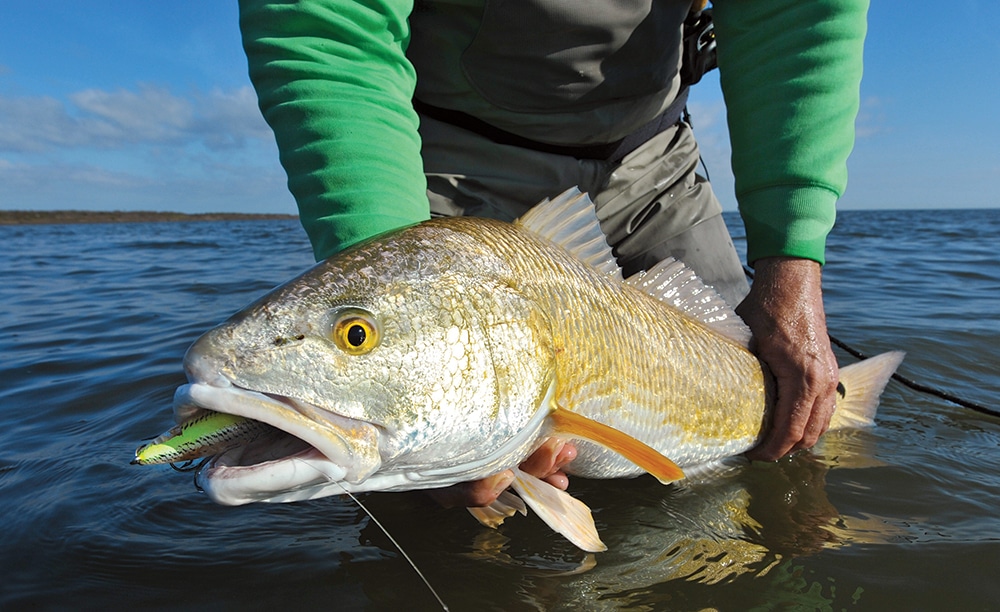
Both captains agree on lure choice: Bass Assassins in either a 4- or 5-inch Sea Shad in Chicken-on-a-Chain color work well. “When the water gets clear, I like Opening Night or Glow colors,” says Grimes. Both captains note consistent topwater action, especially when the reds get into a glass minnow eat-a-thon. Says Grimes: “It’s not uncommon to have redfish swimming all around my customers, between our legs and even running into us. It’s pretty special to see a herd of them coming and be able to pick apart the edges of the school with topwaters. Wade-fishing allows us to do that.”
Grimes prefers smaller topwater lures like MirrOlure’s She Pup in pink-and-chrome as well as Super Spook juniors in chartreuse-and-chrome. Redfish are nose-down predators rather than nose-up feeders like seatrout, so the hookup ratio is a bit better with the smaller topwater lures. “We all know redfish have a tougher time eating big topwaters, plus those smaller lures mimic glass minnows. But don’t get me wrong: The bigger ones crush the bigger topwaters.” And he is never afraid to go old-school on these shallow-water bruisers: “Nothing can beat the consistency of a gold spoon.”
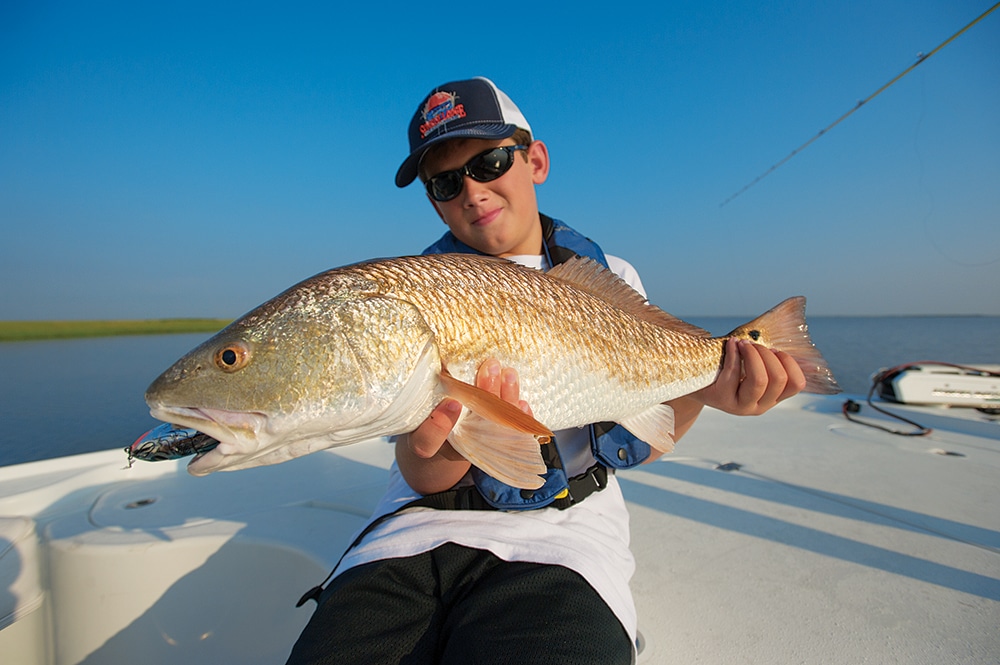
Back Bays and Bruisers in Boats
Juvenile redfish spend their first year inside Texas estuaries foraging on shrimp, crabs, menhaden, mullet and other species that seek shelter in the emergent coastal wetlands. The abundance of bait produces explosive growth rates, according to Jerald Horst, author of The Angler’s Guide to Fishes of the Gulf of Mexico. By the age of two, females can grow to an average of nearly 28 inches and weigh close to nine pounds, while their male counterparts hit eight pounds. As the lunar effects of spring push fertile green water into the bays, Grimes pursues redfish into the back bays where they forage and grow. The back lakes of West Bay — Oyster Lake, Crab Lake and Mud Lake — become good areas to target them. “All the lakes come into play,” says Grimes. Typically he uses a sliding-cork rig to locate schools as he drifts across reef and structure. “We have been using MidCoast Product’s Nexus corks over the Bass Assassins. They work really well at locating schools.” The area is known as a fantastic bull red fishery as well. “We are able to catch really big bulls at our passes too, and fall and spring are incredible,” he says.
Bull reds come to the forage-producing passes like geese to wheat fields in these parts. While seasoned fishermen usually key in during fall (which is notorious for producing both larger fish as well as the greatest number of them), anglers sometimes overlook the spring big-fish run. Those in the know consider the full moon in April the start of a spectacular post-winter run of the bruiser reds. According to Grimes, the bull reds are abundant: “We fish the jetty of the Colorado River, and even though it’s somewhat shallower than other passes, we will make the short run to the Port O’Connor Jetty.” Grimes’ technique is typical and incorporates circle hooks on Carolina-rigged mono with egg sinkers up to 2 ounces. He likes fresh cracked crab or cut mullet. “The Port O’Connor pass is deeper. Typically I like to slow-drift or anchor in about 35 feet of water. The fish continue to move in and out of passes and estuaries through May and June as well, but by July, the fish scatter and school offshore,” he says.
Twice a Day
There is always something magical about a sunrise in paradise. As we relaxed after a full day of catch-and-release fishing, I recalled that amazing East Matagorda sunrise, soon to be rivaled by West Matagorda’s sunset. Here in South Texas, East and West Matagorda Bay anglers are honored to see it twice, especially when viewed from the deck of the Sunrise Lodge.









